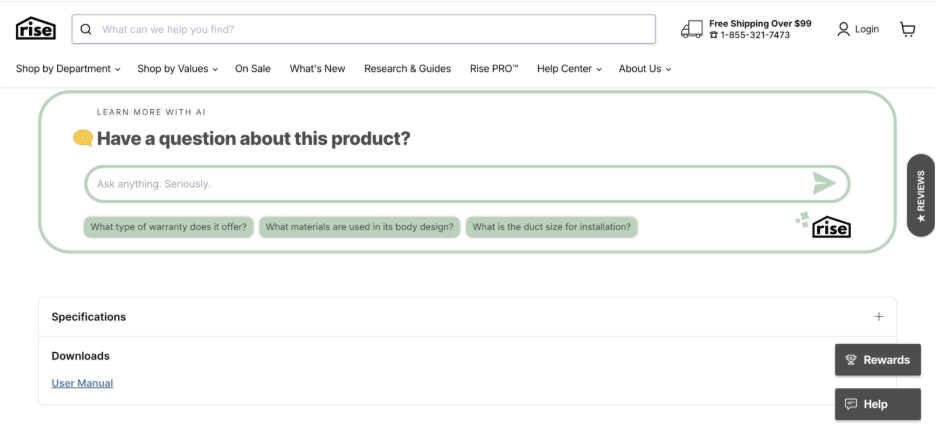

“I don’t think it matters how great a service you offer or how fast you are. You’re always gonna get chargebacks.
- Matt Daigle
CEO of Rise (a sustainable home improvement products store)
Chargebacks have quietly grown into a multi-billion-dollar problem, one that almost every merchant, big or small, has dealt with at some point.
Understanding the extent of the problem, we wanted to look beyond the surface and see how merchants are handling chargebacks in real business situations.
So, we spoke to several merchants across industries, from golf accessories to premium collectibles, high-value coffee machines, and even sustainable home improvements, every single one of them said,
“Yes! we’ve faced chargebacks”.

Some ignored them, some fought back, and a few even won!
But all of them agreed on one thing: it’s a massive pain.
On Reddit, a small home-decor seller shared how they lost $420 to a fraudulent chargeback even after providing proof of delivery and email confirmation from the buyer.
“Everything was legit. Tracking showed delivered, the buyer confirmed they got it and were happy. A month later I still got hit with a chargeback for ‘unauthorized transaction.’ The funds were frozen for days while I scrambled for evidence. It was terrifying.”
The comments were flooded with similar stories: merchants losing time, money, and sanity while banks and processors rarely take their side.
One seller put it bluntly:
“Chargebacks are the tax of eCommerce.”
And it does make us wonder- If everyone knows it’s such a big problem, why hasn’t more been done to stop it?
Chargebacks were never meant to work this way. They were introduced in the 1970s to protect consumers from fraudulent or misleading merchants as credit card use expanded. Somewhere along the way, that safety net turned into a loophole for fraudulent activities.
So, instead of waiting for the system to change, many merchants have built their own defense strategies.
When we asked them, “How are you dealing with chargebacks?” Their approaches were surprisingly practical.
They’ve tested things, lost money, learned patterns, and figured out what actually works.
Of course, one can’t always prevent chargebacks, but we can learn to deal with them smarter.
Here's what worked for the merchants we interviewed-
One of the simplest, yet most overlooked chargeback defenses starts long before a transaction happens; on the product page.
Across industries, most disputes stem from mismatched expectations. When customers don’t fully understand what they’re buying, the smallest delay or confusion can trigger a “not as described” or “item not received” claim.
Matt Daigle, CEO of Rise, a B Corp sustainable home improvement organization, told us:
“We try to be as transparent as possible on all our product pages. The amount of information we give is quite thorough, lengthy descriptions, documentation, videos.
We also layer in our own content; if you’re on a water heater, we link it back to what are the top features to look for in the best water heater.”
To keep disputes low, his team built product pages that give buyers complete clarity before purchase, so they can see, understand, and compare before spending on high-ticket items.
They’ve also added an AI-powered product assistant that lets shoppers ask questions directly on the page, things like “What type of warranty does it offer?” or “What’s the duct size for installation?”

This feature turns passive listings into interactive, self-serve conversations.
It removes uncertainty before checkout and documents every answer within the same ecosystem, another form of pre-purchase evidence if confusion arises later.
This was further corroborated by a former U.S. bank employee who worked in credit card disputes. He explained it on Reddit:
“Clear communication : Make sure your product or service descriptions, pricing, and terms are accurate to set the right expectations.
Detailed receipt : Always include your contact information, a clear description of the item, and total amount charged.”
When everything is visible, what’s being sold, when it’ll ship, how it installs, and who to contact, there’s less room for misunderstanding.
Some chargebacks can be prevented with better communication. Others require stronger internal boundaries.
That shift is clear across two very different businesses: a sports training company that sells swing-speed aids, and a health equipment retailer that handles high-value massage devices.
Both run on Shopify, but how they use it to filter risk looks completely different.
Harley Abrams, Director of Sales and Operations at SuperSpeed Golf, said chargebacks often came from orders that showed early signs of fraud. Over time, his team built a structured process to identify and filter those before shipping.
“Once we moved to Shopify, we had a better idea of what orders are fraudulent and what aren’t. We can cancel those and refund them and not ship anything right away. That’s cut down on that.”
Their system relies on structured verification instead of reaction:
That verification serves two purposes. It filters out likely fraud, and more importantly, it creates evidence.
As Abrams explained, the ID and card image “can be used as evidence against them in case there is a chargeback going forward, the communications as well as the documentation.”
He also added that most chargebacks now come from subscriptions, typically low-value renewals.
“We usually get like one a month where instead of canceling the subscription they just go, ‘I’ll just submit a chargeback instead.’ It’s an extra $15. It’s not the end of the world, and we usually don’t even try and fight those, it’s not worth our time.”
Subscriptions can quietly trigger chargebacks, too.
Recurring payments often catch customers off guard, especially when they’ve forgotten about a renewal or don’t see a clear way to cancel.
A simple reminder before renewal, clearly stated terms, and an easy cancellation flow can close that gap before it turns into a dispute.
David Schwartz, Director of eCommerce at MedMassager, used Shopify Flow to hardwire chargeback prevention into their operations.
“We used to have quite a high chargeback volume. I created a Shopify Flow that cancels any high-risk order automatically. Now we get less than ten a year.”
His logic is straightforward:
Before automation, Schwartz said the company lost tens of thousands of dollars a year to chargebacks. Now, those cases are rare and predictable.
Another merchant on Reddit explained how he now intercepts disputes before they escalate:
“If you want one automation strategy that gives you leverage, go all in on pre-dispute alerts like Ethoca, Verifi, Midtrans, or Chargeflow. They let you intercept disputes before banks get involved. You can issue refunds, clarify with the buyer, or offer credit right when the chargeback’s being filed. The customer doesn’t even notice.”
On another internet thread, one seller described “spending weeks gathering tracking numbers, photos, and customer messages only for the bank to side with the buyer anyway.”
Others mentioned that automation doesn’t fix the bias, but it fixes the process.
Automation and documentation can’t change the rules, but they shift the balance. Whether through Shopify Flow, pre-dispute alerts, or integrated verification, the point isn’t to win more arguments; it’s to have fewer to fight.
In the category of trading cards and collectibles, one opened box can erase its entire value. That’s the reality Hobbiesville, a Canadian hobby and collectibles retailer, operates in every day.
Co-founder Edmond Georges built his chargeback defense around that fragility.

• Carrier PIN on delivery.
“We have been working with carriers that request a pin right from the customer in order to be able to release the item.”
This makes delivery conditional on a customer-provided code at the point of release.
• Photographic delivery evidence.
“We have pictures of the item sitting on the porch. We don't always win those.” Photos are captured and stored, but Georges says “We don't always win those”
• Rotating alphanumeric code on the processor descriptor.
“In our payment processor name, we change an alphanumeric code at the end. So if you bought something from Hobbiesville, you'd notice that it says like Hobbiesville 6O7S.”
• Cancel if buyer can’t confirm the code.
“If you stole a credit card and you had like, CVV card number, billing information, whatever. We would still cancel your transaction because if you don't have control of the card, you wouldn't be able to get that code.”
To be clear,
Sometimes the issue isn’t system error or confusion, its fraud, plain and simple. People are trying to trick the system.
Dan Carey, e-commerce manager at Voltage Coffee, explained:
“Unfortunately, yes, we do get a fair amount of chargebacks. I think we actually probably win the majority of them. It seems to me that in most cases people are just trying to see what they can get away with".
In certain categories, chargebacks aren’t the result of miscommunication or technical error; they’re intentional. Customers receive the right product, use it, and then dispute the payment anyway, betting that the system will side with them.
He said, “But we didn’t ship the wrong thing. They got exactly what they ordered. They knew what the price was, what they were charged, and what the price was. And maybe if I complain enough, I’ll get this $1,200 thing for free”.
They're what many merchants recognize as opportunistic behavior, when customers dispute legitimate orders hoping the system tilts in their favor.
So, at the end, each of these strategies reflects the same shift we’ve seen across merchants: chargebacks aren’t fought with one-size-fits-all solutions.
They’re managed with the tools, proof, and patience that fit their category best.
But the goal stays the same: stop risky orders before they start, and document everything that moves.
Finally,
No merchant we spoke to believe chargebacks can be fully eliminated, but most agree they can be anticipated.
There’s no single fix for chargebacks. But what’s emerging is a layered defense, built through transparency, automation, and documentation, that makes every order harder to dispute, and every claim easier to prove.
Because at this point, the real question isn’t how do you stop chargebacks? How early can you see them coming?
Chargeback prevention doesn’t end at checkout. It extends into how post-purchase issues are handled.
Warranties and service coverage don’t just build trust after purchasing; they create a verifiable record of coverage and intent.
And when something goes wrong, the resolution moves through verified systems, not disputes.
With SureBright’s AI-powered product protection, merchants can automate warranty coverage, streamline claims, and give customers a transparent way to resolve issues without friction.
If you’re rethinking how to strengthen that trust after the sale, it might start with how you protect what you sell. Contact us to learn more.